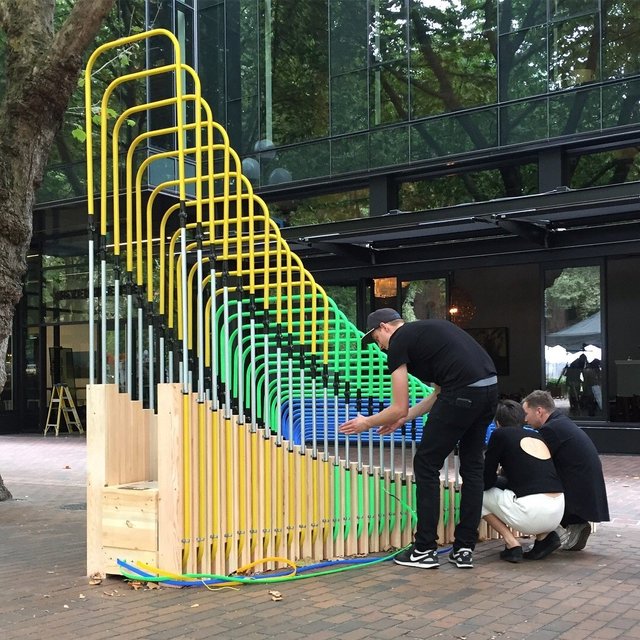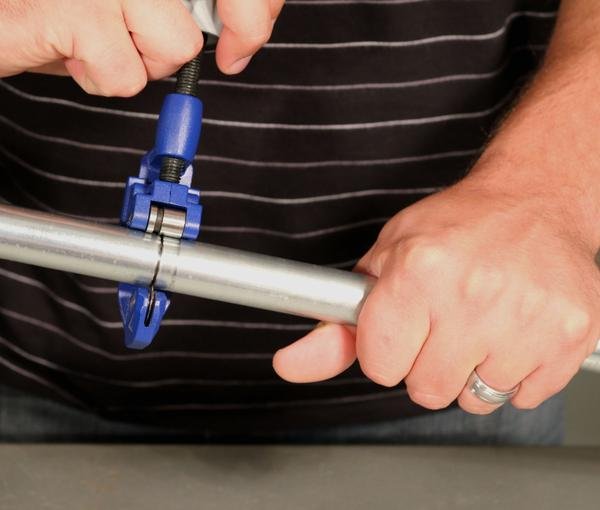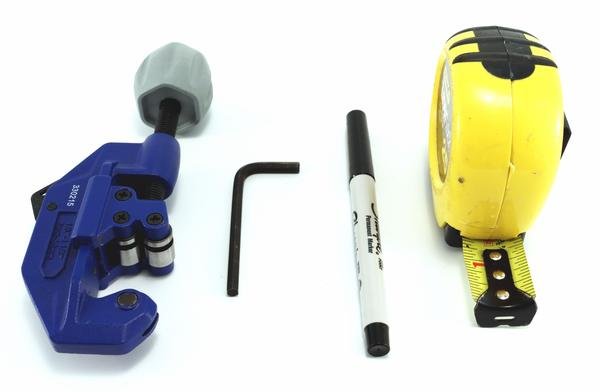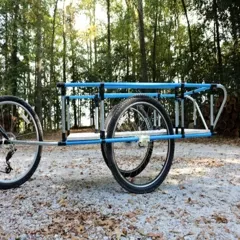WHAT TOOLS ARE NEEDED FOR DIY PIPE PROJECTS ?
The value of theglobal DIY market has been growing steadily from 2013 through 2018. The market size was $31.9 billion in 2013, and by 2018, it will have grown to $43.7 billion. It's an expanding market driven by people who want to save a dime here and there.
Are you into structural pipe art?

If yes, you can save lots of money over the long-term by not hiring a contractor. Nowadays, every DIYer owns a toolbox, and you're no exception. You need to start collecting high-quality tools for your toolbox. Maybe you like small DIY projects. Or, maybe you get a bigger kick out of completing larger EMT conduit projects. Regardless of your preference, here's a list of DIY tools you should own.
SCREWDRIVER
You can do a lot more with a screwdriver than just screwing and unscrewing fasteners. It's among the most prominent of must-have tools for DIY projects whether you're doing a small project or a large one. Screwdrivers come in various lengths and tip sizes.
The right screwdriver is one that fits perfectly in the head of the fastener you want to affix or remove. There are two types of screwdrivers. There are flat-head screwdrivers and, the more popular, Phillips-head type. Both are essential home tools, and you need them as part of your DIY toolkit.
CLAW HAMMER
With a good claw hammer, driving nails into surfaces and pulling them out should be pretty straightforward. But a hammer isn't only good for pounding in and removing nails. It comes in handy every time you need to whack something. What works better than a claw hammer when you need to place some lumber into an opening or a space that needs to be covered securely?
Some claw hammers have a wooden handle while others feature a fiberglass version. These two types are affordable and durable, but they'll never outlast an all-metal hammer.
ADJUSTABLE WRENCH
You won't always use screws to fasten things together. Sometimes, you'll want to use nuts and bolts. Tightening or removing bolts is a task best completed with an adjustable wrench.
This kind of wrench lets you alter the width of the "jaw" to fit onto different bolt sizes. Wrenches, just like many other tools, come in various lengths. For large jobs, you'll want a 10-inch wrench. With such a wrench, tightening or loosening relatively large bolts is a breeze.
TAPE MEASURE AND LEVEL
One of the essential tools needed when working large DIY projects is a tape measure. In pretty much every DIY pipe project, it becomes necessary to cut EMT conduit to a specific size. You need to get the measurements right. And a tape measure is the best tool for that. A retractable tape model that can measure up to 25 feet should be capable of completing all measures required for your basic DIY jobs.
When you're building structural pipe shelves in the kitchen, you need a level. This tool helps ensure that boards, or lumber, or other materials sit in a perfectly horizontal position. The only way to make that possible 100% of the time is to use a level.
If money isn't an issue, buy a laser level. This tool enables hands-free leveling, but it costs more than the typical 3-4 foot metal level.
However, it's not necessary to buy a level when you can level virtually via anapp.
ELECTRIC DRILL
For most small DIY projects, you probably won't need a drill. But no handy person goes very long without owning a high-quality electric drill. A drill is a quintessential workhorse in your toolbox. You can use it to drive screws. It's also the tool you need to drill holes in all kinds of spaces, including sinks and countertops. Also, you can swap bits and grind or sand a whole range of hard materials. And did you know you can even use it to mix your paints?
PAINTBRUSHES
What do you use when you want to address small flaws on surfaces such as walls or furniture? Grab a paintbrush and get the job done, of course. That's why you should add different kinds of paintbrushes to your toolbox. You need round brushes, filberts, fans, rigger brushes, flat brushes, and other types of brushes.
PLIERS
A pair of high-quality pliers come in handy in many different DIY situations. What if you have misplaced your claw hammer but still need to pull a few nails? Use pliers. You can also use this tool to cut wires. Or to pinch wires together when you need to splice them. Also, you can use pliers for loosening nuts and bolts.
GLOVES, GOGGLES, AND MASKS
Everyone needs protective gear regardless of the size of their DIY pipe project. You require goggles to keep your eyes safe, and gloves to protect your hands. And the only way to prevent dust from entering your bloodstream is to wear a mask.
UTILITY KNIFE
Why do you think they decided to call it a utility knife? It's one of the most useful large DIY project tools you'll ever need. Whether you want to cut some rope, sharpen your pencil, or open boxes, a utility knife has got you covered. The best utility knife features a rubber-covered handle. It also comes with built-in storage for the blade.
TOOLS FOR CUTTING CONDUIT
We recommend three options for cutting your EMT conduit:
ABRASIVE CHOP SAW
This is a circular saw that allows you to cut hard materials like EMT conduit. These portable saws can make your job much easier!
Power tools need to be selected based on their performance rather than their appearance.
There are many options, but these are a couple that we recommend:
DEWALT D28715 14-Inch Quick-Change Chop Saw
DEWALT Metal Cutting Saw, 14-Inch (DW872)
COMPACT BAND SAW
If you’re on the go, a compact band saw would be a great addition to your DIY toolkit.
A compact band saw allows you to cut conduit in-place, overhead, or in tight spaces.
We highly recommend this model from Milwaukee Electrical Tool.
SNIPS
Snips, which can also be referred to as shears, are small hand tools used to cut different materials like conduit.
Snips come in two broad categories:
TINNER’S SNIPS
Tinner’s snips are very similar to scissors.
COMPOUND-ACTION SNIPS
For an increased mechanical advantage, compound-action snips use a compound leverage handle system.
For your DIY pipe projects, we recommend Tinner’s Snips, andwe love using this pair from Hakko.
PIPE CUTTER
What cuts EMT conduit better than a pipe cutter? Nothing!

CONDUIT BENDER
A conduit bender allows you to bend angles in conduit by hand.
These are some things to remember when bending conduit:
Use the correct size bender for the conduit size you’re bending. Common sizes include ½”, ¼”,1”, and 1-¾”
You may have to overbend the conduit to allow for proper spring back.
Measure and properly mark your conduit before bending to avoid rework.
Protect yourself! Always wear protective gear and not overexert.
REAMER
WHAT IS CONDUIT REAMING?
To ream your conduit means to remove any burrs or rough edges from the material.
Conduit reamers allow you ream conduit and install fittings in a fraction of the time it would take manually.
Check out this option from Dewalt.
If power tools intimidate you, you could also use a hand reamer.
We recommend this option, from TIPU.
T-HANDLE REX
Lacking the hand strength to tighten and secure the bolts for your build? A T-Handle Rex can help you do the job!
HEAT GUN
A heat gun is perfect for shrinking tubing and wrap.
Check out the video below for tips on getting started.
SECURING CONDUIT DURING THE CUTTING PROCESS
METAL PIPE VISE
A metal pipe vise is great for holding down conduit while cutting it.
Typically, a vice consists of two parallel jaws for holding the workpiece, with one of the jaws fixed and the other movable by a screw, a lever, or a cam.
We recommend the forged pipe vise from HFS.Review its features here.
QUICK CLAMP
A quick clamp allows you to hold down conduit on a table while cutting with a pipe cutter.
As with the other tools on this list, you have many options for quick clamps. We suggest the QUICK-GRIP bar clamp from IRWIN.Check out its features and reviews here.
DON’T FORGET ABOUT THE ORGANIZATION OF YOUR TOOLS!
While having the rights tools is important, you also want to take steps to ensure you’re as organized as possible. This helps with safety, and in some cases, your sanity!
TOOL BELT
Going back and forth between different tools on your build? A tool belt is a great way to organize everything so that it’s nearby while keeping other tools out of the way.
TOOLBOX
What’s a DIYer without a sturdy, durable toolbox?
OEMTools makes great products,as you can see here.
START BUILDING YOUR DIY TOOLBOX NOW

It took the Romans years to build Rome. Similarly, building a toolbox isn't a one-day affair. It takes time and money, and both are resources very few people have in abundance. So, take a look at what's in your toolbox.
Do you have the best DIY tools a DIYer deserves? If not, start collecting the tools you need one-by-one. Hopefully, it won't be long before you have a complete essential toolkit.
MAKE YOUR DIY PIPE PROJECT A SUCCESS
The journey toward DIY project success starts with obtaining the right tools. That's why every DIYer who craves efficiency invests in a set of high-quality tools. Paintbrushes, gloves, masks, pliers, a drill, adjustable wrench — you need them all.
With the right tools at hand, these are just a few examples of the builds you can create with EMT conduit:



.jpg)
But having tools is just one part of the equation.
You also need supplies includingpipe fittings,caps, andmore. Don’t forget conduit!
Need professional advice before adding tools for your DIY projects?
Talk to us today.You can also check out our Getting Started guide for more info.
We’re happy to answer all of your questions!